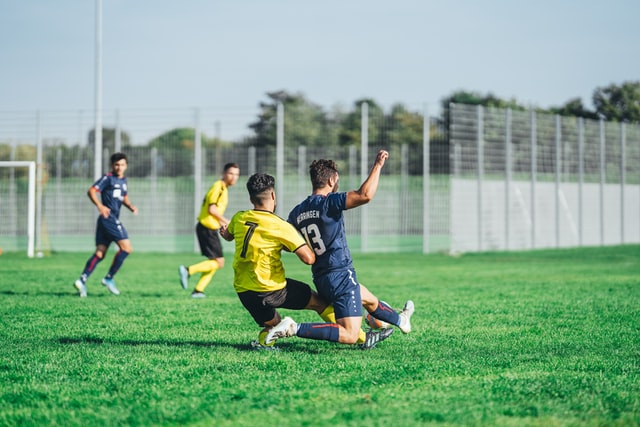To those of you that are new to the beautiful game of soccer, you might be wondering – is soccer a contact sport? After all, when compared to American football and ice hockey, soccer certainly seems a little less rough than some of our nation’s most popular sports.
In this article, we explain some of the rules around contact in soccer so you know what to expect when you take to the field for the first time.
So, is soccer a contact sport?
Yes, soccer is a contact sport. You can tackle your opponents to win the ball back for your team, and you will find that most matches are a lot more physical than they look when you’re watching on from the sidelines. Below, we look at some of the things you need to know about making contact in soccer so you don’t end up committing a foul.
How much contact is permitted in soccer?
The key thing to understand about contact in soccer is the term ‘excessive force.’ While it’s impossible to describe every scenario in which contact is permitted in soccer, this term will help you understand what is deemed to be reasonable.
Excessive force is the term that referees use to decide if a player has endangered an opponent on the field. If the referee decides that excessive force has been used in a challenge, they will send the offending player off. This is sometimes also referred to as dangerous play.
Another important consideration when it comes to contact in soccer is whether or not you play the ball. If you tackle an opponent and play them first, rather than the ball, you will commit a foul. Depending on the severity of the foul, you might be issued a yellow or red card.
So, the bottom line is that some degree of contact is permitted in soccer, but if you use excessive force, you will be punished by the referee.
When is contact a foul in soccer?
There are lots of ways to commit a foul in soccer. But in relation to making contact with an opponent, fouls are usually committed as a result of mistimed slide tackles. As mentioned above, you need to play the ball first, or a free kick or penalty will be awarded to the other team.
Another foul relating to contact is if you start a fight with an opponent. You probably won’t be surprised to hear this, as fighting is outlawed in most team sports! Still, it’s worth realizing that soccer is not permitted on the soccer field.
Contact fouls also occur when players deliberately body-check or prevent their opponents from proceeding with the ball by charging into them. The referee will decide upon the severity of the tackle before issuing you with a card, as well as penalizing your team.
How rough can you be in soccer?
If you’re too rough in soccer, you will be penalized. By too rough, we refer you again to the phrase ‘excessive force.’ While you might think this sounds overly subjective, it’s the only way to understand how a referee judges the severity of a foul on the soccer field.
That being said, there’s absolutely nothing wrong with going in hard and fair against your opponents. In fact, lots of soccer teams develop a reputation for being aggressive on the field – just look at Diego Simeone’s Atletico Madrid team, and you will know what we mean!
Provided that you stay within the rules of the game and don’t use excessive force, you can make as much contact as you like with your opponents. Just remember, if you dish it out on the field, you have to take it back, so be prepared for a feisty game against your opponents!
Is soccer dangerous?
Generally speaking, soccer isn’t particularly dangerous. It’s a great game to get your children into, as kids’ soccer is generally played in good spirits, and it’s not very aggressive.
As you get older, soccer tends to get a little rougher, as people are much stronger and more willing to put in robust tackles and challenges out on the field.
Still, when you compare it to the likes of American football and ice hockey, soccer is nowhere near as dangerous. Still, you need to be careful, and injuries do occur, as we explain below.
What happens if you get injured in soccer?
As is the case with every sport, injuries are common in soccer. Players get injured right the way through the season, and the severity of an injury varies. One of the worst injuries soccer players get is ligament damage, as it takes a long time to repair and usually puts them out for the season.
If you get injured during a soccer match, you will need to leave the field of play. Thankfully, you can be replaced by a teammate in the form of a substitution, so you don’t need to worry about your team going down to fewer players.
After the game, you will need to make sure you rest and recover as best you can. It’s best not to rush back after a soccer injury, as you can do more harm than good in the long term.
Recap: Is soccer a contact sport?
Although there isn’t as much contact in soccer as there is in games like American football and ice hockey, players are permitted to tackle and challenge one another for possession of the ball.
The main thing to take away from this article is the term – excessive force. This refers to occurrences on the pitch when a player has made too much contact with an opponent, and the referee is likely to send them off.
But provided your contact is within the stipulated rules of the game, you can still be aggressive and do everything you can to help your team win.

